Overview
The article presents a structured approach for transitioning to compostable flexible packaging. It underscores the importance of:
- Evaluating current practices
- Selecting suitable materials
- Educating stakeholders
Each step is backed by evidence of the increasing consumer demand for sustainable options and the environmental advantages of biodegradable materials. This highlights the imperative for businesses to adapt to these practices, addressing both ecological and economic motivations. By embracing these changes, companies can not only meet consumer expectations but also contribute positively to the environment.
Introduction
The escalating concern regarding plastic waste has catalyzed a notable transition towards sustainable alternatives, particularly in the realm of compostable flexible packaging. This innovative solution not only pledges to diminish environmental impact but also resonates with the growing consumer demand for eco-friendly products.
Nevertheless, the shift to compostable packaging presents its own set of challenges—how can businesses adeptly navigate this intricate landscape to secure a successful transition?
By delving into the steps necessary for implementing compostable flexible packaging, we uncover valuable insights that can help overcome obstacles, all while maximizing benefits for both the environment and the bottom line.
Understand Compostable Flexible Packaging
Compostable flexible packaging refers to materials specifically created to break down into natural components when placed in a composting environment. In contrast to traditional plastics, which can take hundreds of years to break down, biodegradable materials are derived from renewable resources such as plant-based bioplastics, paper, and other organic substances.
Understanding certifications like ASTM D6400 or EN 13432 is crucial, as these ensure compliance with specific compostability standards. By familiarizing yourself with the lifecycle of compostable materials—from production to disposal—you will gain insight into their environmental advantages, including reduced landfill waste and a lower carbon footprint.
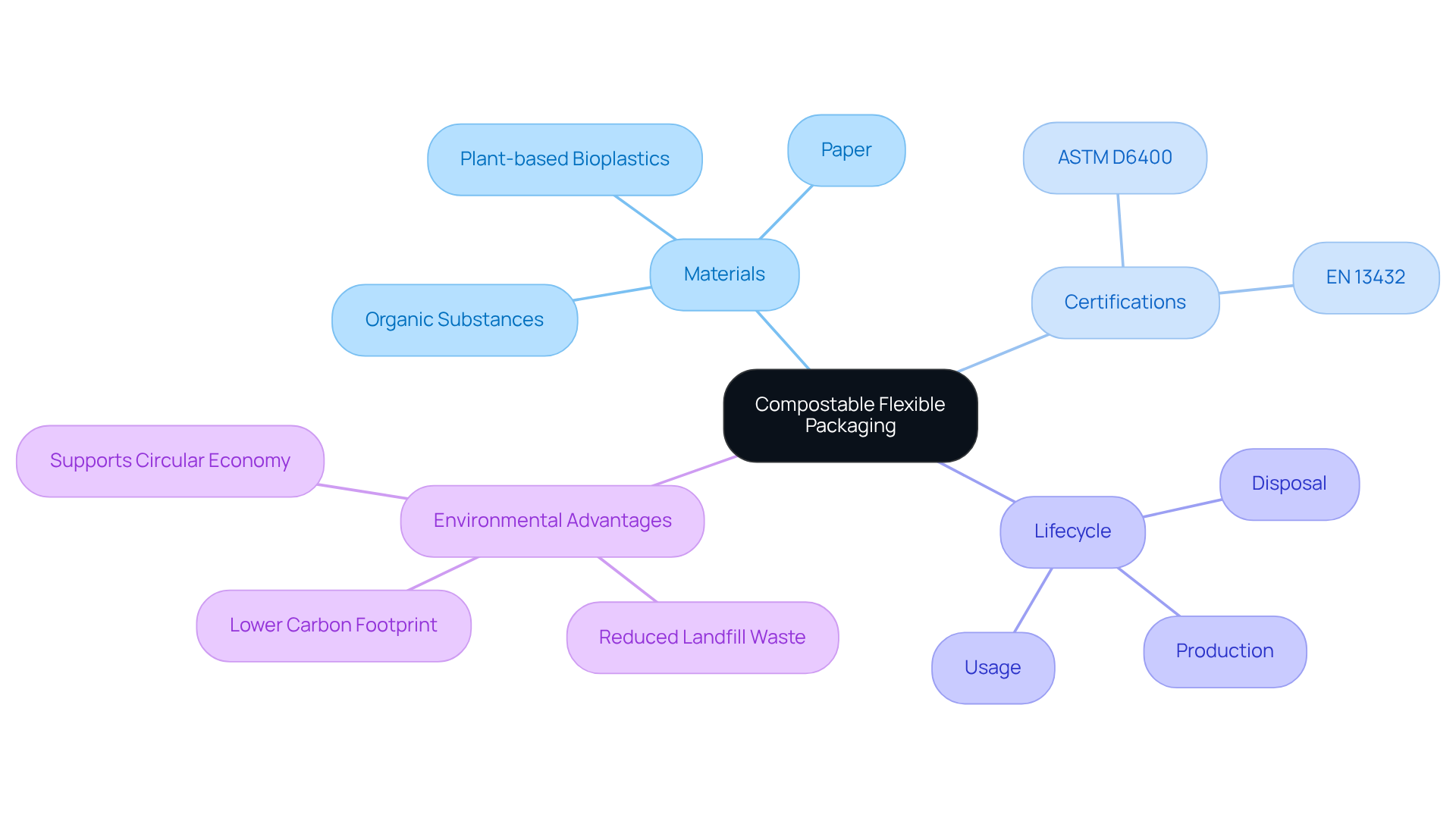
Evaluate Current Packaging Practices
Begin by conducting a thorough review of your current wrapping methods. Evaluate the materials utilized, their environmental impact, and their alignment with your sustainability objectives. Consider essential factors such as cost, functionality, and consumer preferences. Engaging with stakeholders, including suppliers and clients, is crucial; for instance, 87% of consumers would be more inclined to purchase sustainable products if they were easier to find, underscoring the importance of consumer feedback in the audit process.
Companies like Unilever and Nestlé have documented increased customer loyalty following the adoption of eco-friendly practices, illustrating the favorable impact of such transitions on consumer perception. Furthermore, the sustainable container market is projected to grow from USD 292.71 billion in 2024 to USD 423.56 billion by 2029, emphasizing the necessity of transitioning towards biodegradable solutions.
This evaluation will aid in identifying which aspects of your packaging can be improved or replaced with compostable flexible packaging, ensuring that the transition aligns with your business objectives.
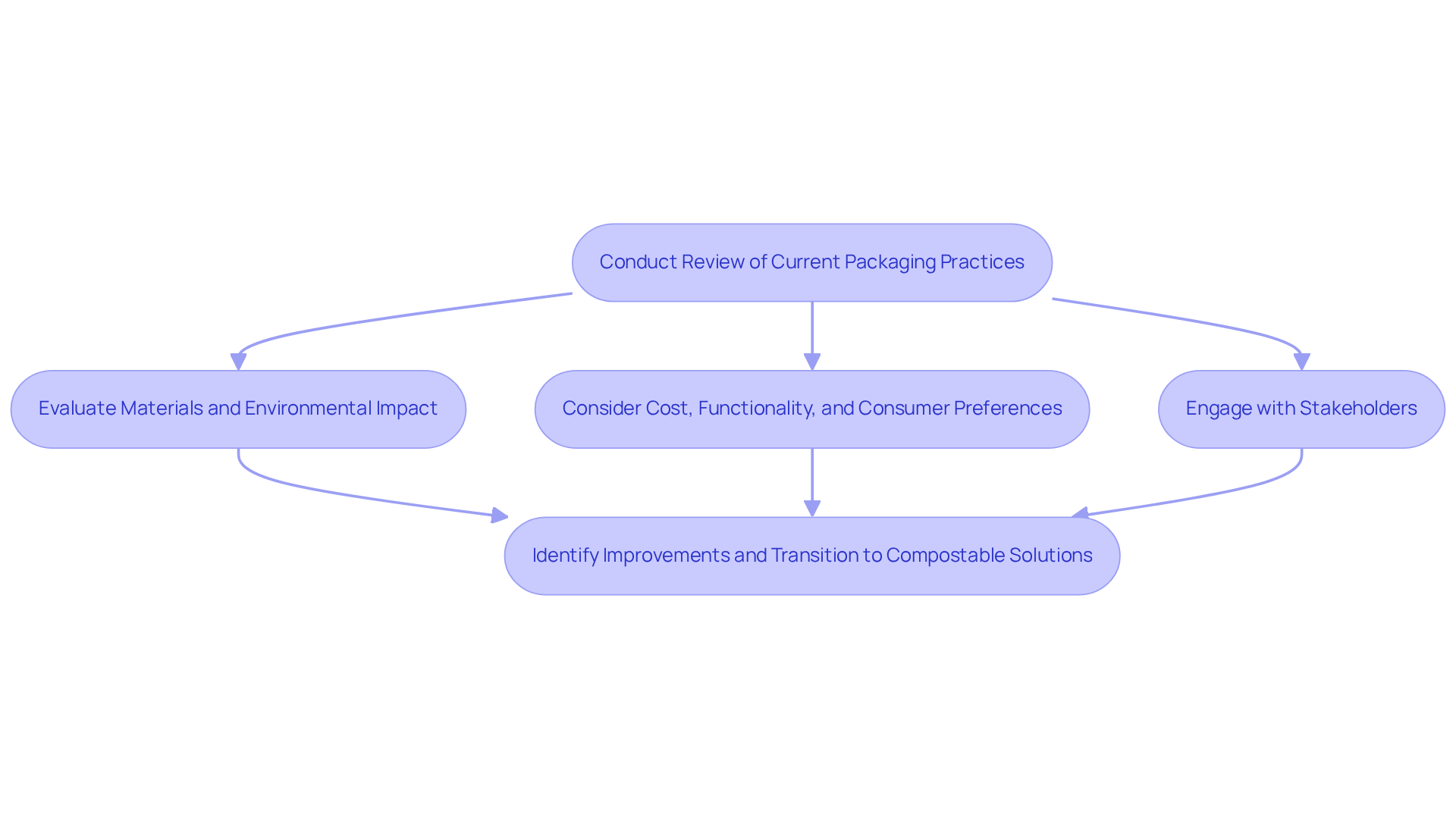
Select Appropriate Compostable Materials
When selecting biodegradable substances, evaluating the specific requirements of your products is essential, including moisture barrier characteristics, durability, and shelf life. Commonly used compostable flexible packaging materials, including polylactic acid (PLA) and cellulose, have demonstrated effective performance across various applications. For instance, PLA is recognized for its biodegradability and is increasingly adopted in compostable flexible packaging because it can decompose into harmless byproducts. The lactic acid market, crucial for PLA production, is projected to expand at a compound annual growth rate (CAGR) of 8.0% from 2022 to 2030, suggesting a favorable trend in the accessibility of PLA resources. Conversely, compostable flexible packaging made from cellulose-based products exhibits high biodegradability rates, achieving up to 100% degradation under optimal composting conditions within 103 days.
Investigating vendors who provide certified biodegradable substances is crucial. Seek those that offer performance data and real-world application examples to ensure the resources meet your operational requirements. As highlighted by industry specialists, 'A biodegradable substance is the ideal solution for certain uses, like food waste bags, where organic matter cannot be separated from plastics.' Furthermore, consider the end-of-life choices for these substances, ensuring that the compostable flexible packaging can be effectively composted in your local area or through industrial composting facilities. This careful selection process is vital for maintaining product integrity while advancing sustainability initiatives.
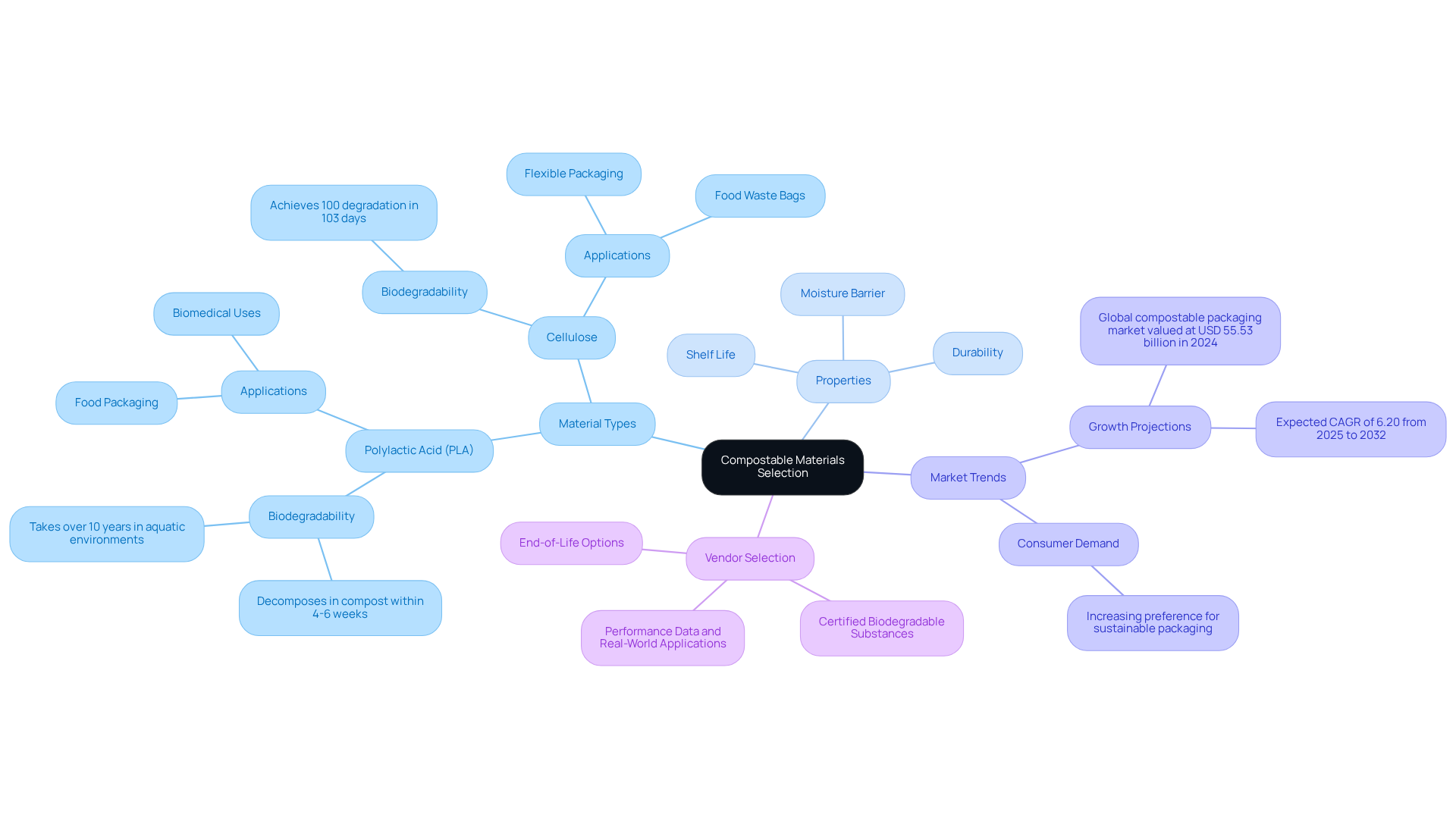
Implement Compostable Packaging Solutions
To implement biodegradable wrapping options effectively, collaborate closely with your suppliers to source the selected components. Revise your production methods to accommodate the new containers, ensuring that your staff is well-trained in handling and utilizing biodegradable materials.
It is essential to inform your customers about these changes, highlighting the environmental benefits associated with the new materials. Additionally, establish a robust system for collecting and managing biodegradable waste, whether through partnerships with local composting centers or by educating consumers on proper disposal methods.
This implementation phase is crucial for ensuring that your transition is not only successful but also positively received.
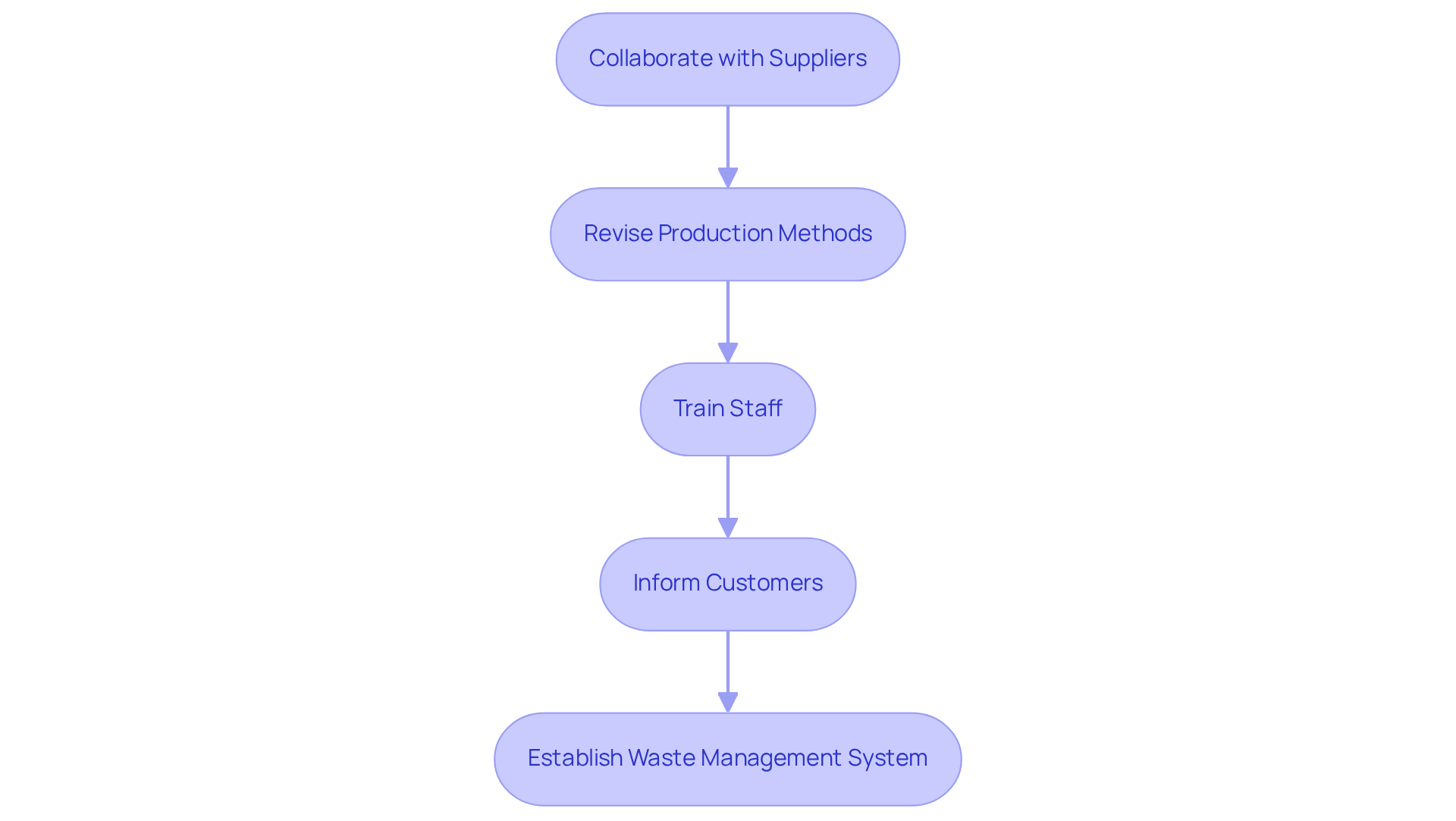
Educate Stakeholders on Compostable Packaging
Informing stakeholders about biodegradable materials is essential for effective execution. Start by creating informative resources that clearly explain the advantages, applications, and disposal techniques of biodegradable containers. Conduct training sessions for employees to ensure they understand the environmental advantages and operational procedures associated with the new packaging. For customers, launch targeted marketing campaigns that emphasize your commitment to sustainability and the positive impact of compostable solutions. Engaging with local communities and organizations can further promote awareness of compostable flexible packaging and composting practices, fostering a culture of sustainability. Notably, 49% of respondents faced difficulty distinguishing between 'compostable' and 'biodegradable', highlighting the need for clear education. Furthermore, a survey showed that 50% of participants improperly dispose of materials marked as 'made from plants', underscoring the significance of appropriate labeling. By increasing awareness and backing among all parties involved, you can greatly enhance the efficiency of your biodegradable initiatives and strengthen your brand's image in the market. As Paula Luu mentions, brands must agree on uniform design and labeling regulations to attain a circular economy for biodegradable products. With the global compostable packaging market projected to reach USD 89.85 billion by 2032, the demand for effective education and communication strategies is more critical than ever.
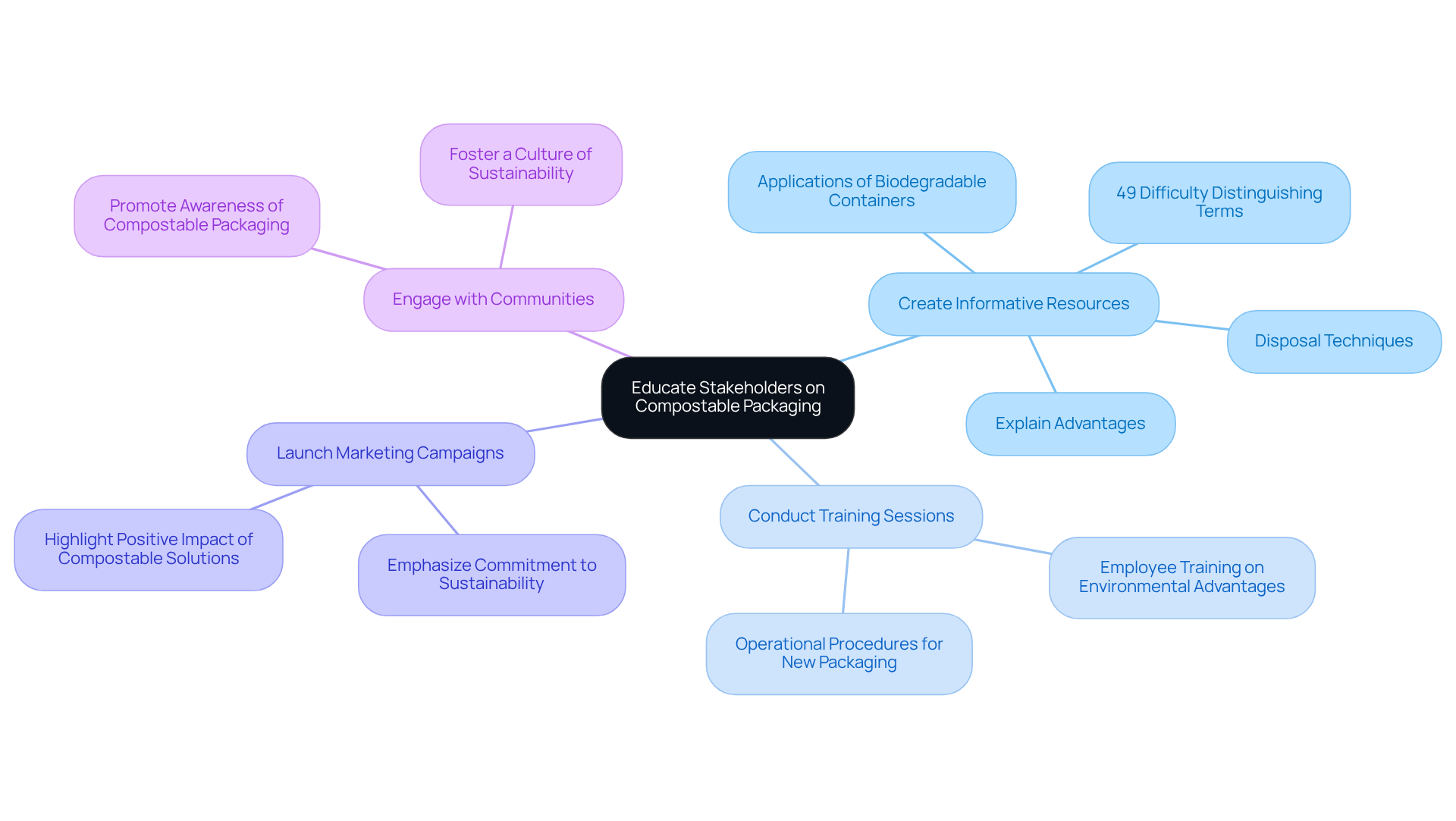
Conclusion
Transitioning to compostable flexible packaging is not merely an operational change; it represents a commitment to sustainability and environmental stewardship. By embracing biodegradable materials, businesses can significantly reduce their ecological footprint while contributing to a healthier planet. This shift not only aligns with growing consumer demand for sustainable practices but also positions companies to lead in a market increasingly focused on eco-friendly solutions.
The article outlines five essential steps to facilitate this transition:
- Understanding compostable flexible packaging
- Evaluating current packaging practices
- Selecting appropriate materials
- Implementing effective solutions
- Educating stakeholders
Each step emphasizes the importance of informed decision-making and collaboration, highlighting that the successful adoption of compostable packaging requires a holistic approach that considers environmental impact, consumer preferences, and regulatory compliance.
As the global market for compostable packaging continues to expand, the need for businesses to adapt and innovate becomes ever more pressing. By prioritizing education and clear communication with stakeholders, companies can foster a culture of sustainability that not only enhances their brand image but also drives meaningful change in consumption patterns. Embracing compostable flexible packaging is not just a trend; it is a vital step toward a more sustainable future.
Frequently Asked Questions
What is compostable flexible packaging?
Compostable flexible packaging refers to materials designed to break down into natural components in a composting environment, unlike traditional plastics that can take hundreds of years to decompose. These materials are made from renewable resources such as plant-based bioplastics, paper, and other organic substances.
Why are certifications like ASTM D6400 or EN 13432 important?
Certifications like ASTM D6400 or EN 13432 are important because they ensure that compostable materials comply with specific compostability standards, verifying their ability to break down effectively in composting conditions.
What are the environmental advantages of compostable materials?
The environmental advantages of compostable materials include reduced landfill waste and a lower carbon footprint, contributing to more sustainable waste management practices.
How can companies evaluate their current packaging practices?
Companies can evaluate their current packaging practices by reviewing the materials used, their environmental impact, and their alignment with sustainability objectives. This includes considering factors such as cost, functionality, and consumer preferences.
What role does consumer feedback play in packaging evaluations?
Consumer feedback is crucial in packaging evaluations, as studies show that a significant percentage of consumers (87%) would be more likely to purchase sustainable products if they were easier to find, highlighting the importance of aligning packaging practices with consumer demand.
What is the projected growth of the sustainable container market?
The sustainable container market is projected to grow from USD 292.71 billion in 2024 to USD 423.56 billion by 2029, indicating a strong trend towards biodegradable solutions in packaging.
How can companies benefit from adopting eco-friendly packaging practices?
Companies can benefit from adopting eco-friendly packaging practices by increasing customer loyalty and improving consumer perception, as demonstrated by companies like Unilever and Nestlé that have seen positive impacts after transitioning to sustainable practices.




